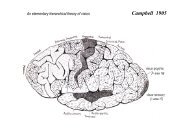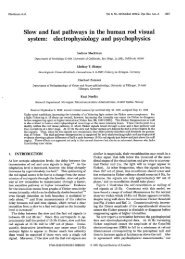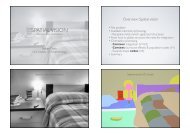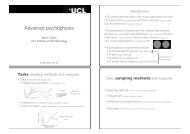Andrew Stockman Colour Vision 1 - CVRL main
Andrew Stockman Colour Vision 1 - CVRL main
Andrew Stockman Colour Vision 1 - CVRL main
You also want an ePaper? Increase the reach of your titles
YUMPU automatically turns print PDFs into web optimized ePapers that Google loves.
<strong>Andrew</strong> <strong>Stockman</strong><strong>Colour</strong> visionMScNeurosciencecourseINTRODUCTIONLight400 - 700 nm is important for vision<strong>Andrew</strong> <strong>Stockman</strong>Lecture notes at http://www.cvrl.orgClick on “MSc Neuroscience” in left menu.No colour…<strong>Colour</strong>…How dependent are weon colour?<strong>Colour</strong> <strong>Vision</strong> 1
<strong>Andrew</strong> <strong>Stockman</strong>ACHROMATIC COMPONENTSCHROMATIC COMPONENTSSplit the image into...But just how importantis colour?CHROMATIC COMPONENTSBy itself chromatic information provides relativelylimited information…ACHROMATIC COMPONENTSHow do we see colours?An image of the world isprojected by the cornea and lensonto the rear surface of the eye:the retina.Rods andconesAchromatic information important for fine detail …The back of the retina is carpetedby a layer of light-sensitivephotoreceptors (rods and cones).Webvision<strong>Colour</strong> <strong>Vision</strong> 2
<strong>Andrew</strong> <strong>Stockman</strong>Human photoreceptorsRod and cone systems are optimized for different light levelsRods• Achromaticnight vision• 1 typeRodCones• Daytime, achromaticand chromatic vision• 3 typesLong-wavelengthsensitive(L) or“red” coneWhy do we have rods and cones?Typical ambient light levelsPhotopic retinal illuminance(log phot td)Scotopic retinal illuminance(log scot td)MoonlightSunlightStarlightIndoorlighting-4.3 -2.4 -0.5 1.1 2.7 4.5 6.5 8.5-3.9 -2.0 -0.1 1.5 3.1 4.9 6.9 8.9Middle-wavelengthsensitive(M) or“green” coneVisual functionSCOTOPIC MESOPICPHOTOPICAbsolute rod Cone Rod saturationthreshold threshold beginsDamagepossibleShort-wavelengthsensitive(S) or“blue” coneRod systemA range of c. 10 6Cone systemA range of > 10 8Rod and cone distributionRod density peaks at about20 deg eccentricity During the day, you have to look atthings directly to see them in detailCones peak at the centreof vision at 0 deg0.3 mm of eccentricity isabout 1 deg of visual angleAt night, you have to lookaway from things to seethem in more detail<strong>Colour</strong> <strong>Vision</strong> 3
<strong>Andrew</strong> <strong>Stockman</strong>Original photographThe human visual systemis a foveating systemSimulation of what we see whenwe fixate with cone vision.Central fovea is rod-free, and the very centralfoveola is rod- and S-cone freeCredit: Stuart Anstis, UCSDPhotopigment molecule (cone)From Sharpe, <strong>Stockman</strong>, Jägle & Nathans, 1999Chromophore(chromo- color, + -phore, producer)Light-catching portion of any molecule11-cis retinal.The molecule istwisted at the 11thcarbon.ChromophoreHow can a process initiatedlike this encode wavelengthand intensity?<strong>Vision</strong> at the photoreceptor stage isrelatively simple because the outputof each photoreceptor is:UNIVARIANTall-trans retinalSide chains omittedfor simplicity.Can it?We’ll come back to this…<strong>Colour</strong> <strong>Vision</strong> 4
<strong>Andrew</strong> <strong>Stockman</strong>Four human photoreceptors with different spectral sensitivities441 500 541 566 max (nm, corneal, quantal)<strong>Colour</strong>…<strong>Colour</strong> isn’t just about physics. For example:0Log 10quantal sensitivity-1-2-3-4-5SRodsNote logarithmicscaleLMTwo metamersof yellow+400 450 500 550 600 650 700Wavelength (nm)Is it <strong>main</strong>ly a property of physics or biology?though physically very different, can appear identical.There are many other suchmetamers or matches…<strong>Colour</strong> <strong>Vision</strong> 5
<strong>Andrew</strong> <strong>Stockman</strong><strong>Colour</strong> mixingWhat can colourmixing tell us aboutcolour vision?<strong>Colour</strong> TVTrichromacy is exploited in colour reproduction, sincethe myriad of colours perceived can be produced bymixing together small dots of three colours.If you look closely at a colour television (or this projector output)…Human vision istrichromaticTrichromacy meansthat colour vision isrelatively simple.It is a 3 variable system…3-coloured dots3-coloured bars<strong>Colour</strong> <strong>Vision</strong> 6
<strong>Andrew</strong> <strong>Stockman</strong>The dots produced by a TV or projector are sosmall that they are mixed together by the eyeand thus appear as uniform patches of colourWhy is human vision trichromatic?The <strong>main</strong> reason, of course, is because justthree cone photo-receptors underlie daytimecolour vision, but it is also the fact that...Short-wavelengthsensitiveor “blue”Middle-wavelengthsensitiveor “green”Long-wavelengthsensitiveor “red”The output of each photoreceptor is:UNIVARIANCECrucially, the effect of any absorbed photon is independentof its wavelength.UNIVARIANCECrucially, the effect of any absorbed photon is independentof its wavelength.“UNIVARIANT”What does univariant mean?M-coneM-coneUse Middle-wavelength-sensitive (M) cones as an example…Once absorbed a photon produces the same changein photoreceptor output whatever its wavelength.So, if you monitor the cone output, you can’t tellwhich “colour” of photon has been absorbed.<strong>Colour</strong> <strong>Vision</strong> 7
<strong>Andrew</strong> <strong>Stockman</strong>UNIVARIANCECrucially, the effect of any absorbed photon is independentof its wavelength.M-coneAll the photoreceptor effectively does is to countphotons.UNIVARIANCEWhat does vary with wavelength is the probabilitythat a photon will be absorbed.This is reflected in what is called a“spectral sensitivity function”.Log 10quantal sensitivity0-1-2-3M-cone spectral sensitivity functionHigh sensitivity(less photons needed tohave an effect)Low sensitivity(more photons neededto have an effect)400 450 500 550 600 650 700Wavelength (nm)Imagine the sensitivity to these photons…000Log 10quantal sensitivity-1-2-3In order of M-cone sensitivity:> > > > > >Log 10quantal sensitivity-1-2-3So, imagine you have four lightsof the same intensity (indicatedhere by their heights)The green will look brightest, thenyellow, then blue and lastly the redwill be the dimmestLog 10quantal sensitivity-1-2-3We can adjust the intensities tocompensate for the sensitivitydifferences.When this has been done, thefour lights will look completelyidentical.400 450 500 550 600 650 700Wavelength (nm)400 450 500 550 600 650 700Wavelength (nm)400 450 500 550 600 650 700Wavelength (nm)<strong>Colour</strong> <strong>Vision</strong> 8
<strong>Andrew</strong> <strong>Stockman</strong>UNIVARIANCEA change in photoreceptor output can be caused by a change inintensity or by a change in colour. There is no way of telling which.M-cone<strong>Colour</strong> or intensitychange??Univariance in suctionelectrode recordingsChanges in light intensity are confounded withchanges in colour (wavelength)Each photoreceptor is therefore ‘colour blind’, and is unable todistinguish between changes in colour and changes in intensity.If we had only one photoreceptor, we would be colour-blind…With three cone photoreceptors, our colour vision is trichromatic…UnivarianceIf a cone is n times less sensitive to light Athan to light B, then if A is set to be n timesbrighter than B, the two lights will appearidentical whatever their wavelengths.Examples: night vision, blue cone monochromats<strong>Colour</strong> <strong>Vision</strong> 9
<strong>Andrew</strong> <strong>Stockman</strong>Trichromacy actually meansour colour vision is limited<strong>Colour</strong> is encoded by the relative cone outputsSo, if each photoreceptor is colour-blind,how do we see colour?Or to put it another way: How iscolour encoded?We confuse many pairs of colours that arespectrally very different. Such pairs areknown as metameric pairs.Many of these confusions would be obviousto a being with 4 cone photoreceptors—just asthe confusions of colour deficient people areobvious to us.Log 10 quantal sensitivity0-1-2-3LMS400 450 500 550 600 650 700Blue lightWavelength (nm)<strong>Colour</strong> is encoded by the relative cone outputs<strong>Colour</strong> is encoded by the relative cone outputs<strong>Colour</strong> is encoded by the relative cone outputsBlue lightBlue lightBlue lightRed light00Log 10 quantal sensitivity-1-2SMLRed lightLog 10 quantal sensitivity-1-2SMLGreen lightGreen lightPurple light-3-3Red lightYellow lightWhite light400 450 500 550 600 650 700400 450 500 550 600 650 700Wavelength (nm)Wavelength (nm)<strong>Colour</strong> <strong>Vision</strong> 10
<strong>Andrew</strong> <strong>Stockman</strong>DETERMINING CONESPECTRAL SENSITIVITIESIn other words…How can we measure how the sensitivity of each cone typevaries with wavelength (or spectral colour)?The cone spectralsensitivities overlapextensively throughoutthe spectrum.Consequently, we haveto use special subjectsor special conditions tobe able isolate the theresponse of a singlecone type.Log sensitivity0-1-2-3-4SM400 500 600 700Wavelength (nm)LNormalProtanopeNormalDeuteranopeM- and L-cone measurementsUse two special types of subjects:DeuteranopesProtanopesLMSL M SProtanopiaLMSL M SDeuteranopia<strong>Colour</strong> <strong>Vision</strong> 11
<strong>Andrew</strong> <strong>Stockman</strong>LAdjusted L-cone dataLog 10 quantal sensitivity-8L-cone-9-10Macular and lens adjusted-11400 450 500 550 600 650 700Log 10quantal sensitivity0-1-2Mean L- and M-cone spectral sensitivity functionsLMS-cone measurementsTwo types of subjects:S-cone (or blue cone) monochromats<strong>Colour</strong> normalsLog 10 difference0.50.0-0.5400 450 500 550 600 650 700Wavelength (nm)-3400 450 500 550 600 650 700Wavelength (nm)LNormalMSS‐cone monochromatL M SSLog 10 quantal spectral sensitivity-6-8-10-12-14-16-18-20-22NormalsASCF BCMsHJ FBLS KSTA PS400 450 500 550 600Wavelength (nm)S-cone dataThe Normal data wereobtained on an intense orangeadapting background that wasthere to suppress the L- andM-cone sensitivities.Log 10quantal sensitivity0-1-2-3Mean spectral sensitivity functionsSThese mean functionshave enabled us to derive“standard” cone spectralsensitivity functions.M400 450 500 550 600 650 700Wavelength (nm)L<strong>Colour</strong> <strong>Vision</strong> 12
<strong>Andrew</strong> <strong>Stockman</strong>Why study spectral sensitivities?NormalTritanopeDeuteranopeA knowledge of the spectral sensitivities of the conesis important because it allows us to accurately andsimply specify colours and to predict colour matches—for both colour normal and colour deficient people(and to understand the variability between individuals).Credit: EuroPuppy BlogPractical implications for colour printing, colourreproduction and colour technology.LMSL M STritanopiaDogs are dichromats with only twocones peaking at 429 and 555 nmLMSBut what happens next (i.e., how is colour encodedafter the photoreceptors)?<strong>Colour</strong> phenomenologyCan provide clues about how colours areprocessed after the photoreceptors…POSTRECEPTORALCOLOUR VISIONWhich pairs of colours coexist in a single,uniform patch of colour?Which pairs never coexist?Reddish-greens? Reddish-yellows?Bluish-reds? Bluish-yellow? ??WHY?<strong>Colour</strong> <strong>Vision</strong> 13
<strong>Andrew</strong> <strong>Stockman</strong>The colour opponent theory of HeringThe colour opponent theory of HeringThe colour opponent theory of HeringReds can get bluer or yellower but not greenerYellows can get greener or redder but not bluerGreens can get bluer or yellower but not redderThe colour opponent theory of HeringThe colour opponent theory of HeringThe colour opponent theory of Heringis opposed toR-Gis opposed toY-BBlues can get greener or redder but not yellowerHow might this be related to visualprocessing after the cones?<strong>Colour</strong> <strong>Vision</strong> 14
<strong>Andrew</strong> <strong>Stockman</strong>Some ganglion cells arecolour opponentSome ganglion cells arecolour opponentSome ganglion cells arecolour opponentImagine that this is the regionof space that the cell “sees” inthe external worldA red light falling on the central areaexcites the cell (makes it fire faster)A green light falling on the surround areainhibits the cell (makes it fire slower)Red-green colour opponencyLGN cellresponsesFourvariants<strong>Colour</strong> <strong>Vision</strong> 15
<strong>Andrew</strong> <strong>Stockman</strong>Blue-yellow pathwaySummaryTrichromatic stageSo that’s colour(chromatic) encoding, butwhat about “luminance”(achromatic) encoding?ACHROMATIC COMPONENTS<strong>Colour</strong>opponent stageCHROMATIC COMPONENTSSource: David HeegerBased on Boynton (1979)In addition to neural pathways that signal colour thereare also pathways that signal intensity or luminance:<strong>Colour</strong> is encoded by differencing the relative cone outputsBlue lightRed lightChromatic and achromaticpathwaysGreen lightPurple lightYellow lightWhite lightBased on Boynton (1979)<strong>Colour</strong> <strong>Vision</strong> 16
<strong>Andrew</strong> <strong>Stockman</strong>But luminance is encoded by summing themBlue light+Green light+Red light+Purple light+<strong>Colour</strong> is in many ways secondaryto luminance +Yellow light+White light++ + +<strong>Colour</strong> <strong>Vision</strong> 17
<strong>Andrew</strong> <strong>Stockman</strong>+ +Rob van Lier, Mark Vergeer & Stuart AnstisBoyntonillusionBoyntonillusionBoyntonillusion<strong>Colour</strong> <strong>Vision</strong> 18
<strong>Andrew</strong> <strong>Stockman</strong>BoyntonillusionFading dotWatercoloureffectPostreceptoral substrates of thechromatic and luminance pathwaysBipolar cellsGanglion cellsChromatic pathways, which produce chromaticpercepts, have been linked to the parvocellularretinal stream.Luminance pathways, which produce achromaticpercepts, have been linked to the magnocellularstream, but also depend on the parvocellularstream.MagnocellularpathwayParvocellularpathwayFrom Rodieck (1998)MagnocellularpathwayParvocellularpathwayFrom Rodieck (1998)<strong>Colour</strong> <strong>Vision</strong> 19
<strong>Andrew</strong> <strong>Stockman</strong>[Based on Boynton (1979)]S-cone vision is slowThere is a complication...The retinal distribution of the magnocellular cells istoo coarse to support finely detailed luminance vision.ParvocellularpathwayMagnocellularpathwaySLOW(Chromatic information)FAST(Intensity information)Austin Roorda, 2004There is a complication...The parvocellular pathway must be double-duty: itsupports finely detailed luminance vision as well as(probably) colour vision.Multiplexing colour andluminance informationParvocellular pathway:High spatial frequencies (detail)Low temporal frequenciesChromaticLower contrast sensitivityMagnocellular pathway:High temporal frequencies (motion)Low spatial frequenciesAchromaticHigher contrast sensitivityAustin Roorda, 2004MagnocellularpathwayParvocellularpathwayFrom Rodieck (1998)<strong>Colour</strong> <strong>Vision</strong> 20
<strong>Andrew</strong> <strong>Stockman</strong>So far, we’ve <strong>main</strong>ly been talking about thecolours of isolated patches of light. But thecolour of a patch depends also upon:(i) What precedes it (in time)COLOUR AFTER-EFFECTS(ii) What surrounds it (in space)COLOUR CONTRASTCOLOUR ASSIMILATIONCOLOUR AFTER-EFFECTS(what precedes the patch)<strong>Colour</strong>after-effectsYou don’t have to see things forthem to produce an after-effect...Beer & MacLeod<strong>Colour</strong> <strong>Vision</strong> 21
<strong>Andrew</strong> <strong>Stockman</strong>Beer & MacLeodMediafireLilac chaser or Pac-Man illusionColor contrastCOLOUR CONTRAST(what surrounds the patch)Jeremy Hinton<strong>Colour</strong> <strong>Vision</strong> 22
<strong>Andrew</strong> <strong>Stockman</strong>COLOUR ASSIMILATION<strong>Colour</strong> assimilationMunkerillusionCOLOUR CONSTANCY<strong>Colour</strong> <strong>Vision</strong> 23
<strong>Andrew</strong> <strong>Stockman</strong><strong>Colour</strong> constancyred<strong>Colour</strong> constancygreenCredit: GegenfurtnerChromatic adaptationand colour constancybluegyellowThe change in colour appearancefollowing adaptation is due tochromatic adaptation. Chromaticadaptation is adaptation to thecolour is of the ambientillumination.Amazing Art, Viperlib<strong>Colour</strong> contrast and colour constancyMonet, ClaudeThe Regatta at Argenteuilc. 187219 x 29 1/2 in. (48 x 75 cm)Musee d'Orsay, ParisDavid Brainard, Viperlib<strong>Colour</strong> <strong>Vision</strong> 24
<strong>Andrew</strong> <strong>Stockman</strong>Stroop effectTEST 1COLOUR ANDCOGNITIONSay to yourself the colours of the ink in which thefollowing words are written -- as fast as you can.So, for RED, say “red”.REDORANGEGREENGREEN BLUE YELLOW PINKBLUE GREENYELLOW PINKBROWN WHITERED ORANGEBut for RED, say “green”BROWNREDWHITEBLUEYELLOWReady, steady…WHITEORANGEGREENBROWNREDHow long?TEST 2McCollough effect test patternMcCollough effect adapting patternBLUEPINK WHITE RED BROWNBROWNREDBLUEGREENORANGEYELLOWBLUEREDORANGEWHITEBROWNREDGREENWHITEREDREDPINKBLUEGREENWHITEHow long?<strong>Colour</strong> <strong>Vision</strong> 25
<strong>Andrew</strong> <strong>Stockman</strong>TritanopeMcCollough effect test patternCOLOUR VISION, COLOURDEFICIENCIES ANDMOLECULAR GENETICSAppearance of visible spectrumCOLOUR VISION ANDMOLECULAR GENETICS<strong>Colour</strong> deficiency simulationsFrom Sharpe, <strong>Stockman</strong>, Jägle & Nathans, 1999<strong>Colour</strong> <strong>Vision</strong> 26
<strong>Andrew</strong> <strong>Stockman</strong>NormalDeuteranopeAppearance of visible spectrumTritanopeProtanopeFrom Sharpe, <strong>Stockman</strong>, Jägle & Nathans, 1999Photopigment moleculeFrom Sharpe, <strong>Stockman</strong>, Jägle & Nathans, 1999Amino acid differencesbetween photopigmentopsinsMWS/LWS cone opsin tuningCytoplasmicside80Transducin, arrestinactivation regionsC-115090C-2160170240C-3250260270C-terminal350330PhosphorylationSV sites360 SSS S V340POLARLWSall withOH group320MembraneExtracellularside706050S110140I100130ECS 190SCE-112040180230220200210E-2280K 310290300E-320Spectral tuning sites180, 277, 285NON-POLARMWSFrom Sharpe, <strong>Stockman</strong>, Jägle & Nathans, 1999K Retinal binding site (Lys312)E Schiff base counterion (Glu129)Chloride binding pocket:Glu - 197His + (& Gln200Lys + )301N-terminal10164/180 261/277 269/285Rods and S cones have 348 amino acids whereas L and M coneshave 364 amino acids – 16 amino acid difference at the N terminal<strong>Colour</strong> <strong>Vision</strong> 27
<strong>Andrew</strong> <strong>Stockman</strong>Amino acid differencesbetween photopigmentopsinsPhylogenetic tree of visual pigmentsAbout 460 – 520 nm Rh1About 460 – 520 nm Rh2Mammals490 - 500 nmlostAbout 420 – 480 nm SWS2lostAbout 355 – 450 nm SWS1365 - 450 nmWhy are the M- and L-cone opsins so similar?Basis fordichromaticcolour visionAbout 490 – 570 nm LWS490 - 565 nmFrom Sharpe, <strong>Stockman</strong>, Jägle & Nathans, 1999mya (million years ago)mya (million years ago)Credit: BowmakerHumans490 - 500 nmlostGene duplication on the X-chromosomeBecause these two genes are in atandem array, and are very similar…lost365 - 450 nmL-conephotopigmentopsin geneM-conephotopigmentopsin geneL-conephotopigmentopsin geneM-conephotopigmentopsin geneBasis fortrichromaticcolour visionmya (million years ago)DuplicationCredit: Bowmaker<strong>Colour</strong> <strong>Vision</strong> 28
<strong>Andrew</strong> <strong>Stockman</strong>Crossovers during meiosis arecommon:Intragenic crossovers produce hybrid or mixed L and M-cone genes0Intergenic crossoverIntergenic crossoverIntragenic crossoverHybrid (mixed)L/M genesMLog 10 quantal sensitivity-1-2-3400 450 500 550 600 650 700Intergenic crossovers produce more or less L and M-cone genes on each X chromosomeFrom Sharpe, <strong>Stockman</strong>, Jägle & Nathans, 1999Intragenic crossoverFrom Sharpe, <strong>Stockman</strong>, Jägle & Nathans, 1999LWavelength (nm)The spectral sensitivities of the hybridphotopigments vary between those of the M-and L-cones depending on where the crossoveroccurs.Single-gene dichromatsMultiple-gene dichromatsAnomalous trichromatsMale observers with twodifferent genes areanomalous trichromatsProtanopeSevereWith a single genemale observers mustbe dichromatsMale observers with two similargenes may also be effectivelydichromats if the two genesproduce similar photopigments.MildProtanomalousDeuteranopeSevereDeuteranomalous<strong>Colour</strong> <strong>Vision</strong> 29
<strong>Andrew</strong> <strong>Stockman</strong>1.00.5SevereDeutan1.00.5NormalMain types of colour vision defects withapproximate proportions of appearance in thepopulation.percent in UKXY inheritance0.0350 450 550 650 7500.0350 450 550 650 750Condition Male FemaleProtanopia no L cone 1.0 0.02Protanomaly milder form 1.0 0.031.00.5SevereProtan1.00.5MildProtanDeuteranopia no M cone 1.5 0.01Deuteranomaly milder form 5.0 0.4Tritanopia no SWS cone 0.008 0.0080.0350 450 550 650 7500.0350 450 550 650 750The emergence of two longerwavelength (M- and L-cones)is thought to have occurredrelatively recently in primateevolution.No red-green discriminationRed-green discriminationWhy is it important?Source: Hans IrtelSource: Hans Irtel<strong>Colour</strong> <strong>Vision</strong> 30
<strong>Andrew</strong> <strong>Stockman</strong>Ishihara platesDIAGNOSING COLOUR VISIONDEFICIENCIESFarnsworth-Munsell D-15Tests measuring colour discriminationFarnsworth-MunsellD-15 testFarnsworth-Munsell100-hue testFrom: Ted Sharpe<strong>Colour</strong> <strong>Vision</strong> 31
<strong>Andrew</strong> <strong>Stockman</strong>MildSevereD15 resultsProtanS-cones are unusualDeutanTritanS-CONE MEDIATED VISION ISUNUSUALRodmonochromatCentral area of the fovea lacks S-cones and is therefore tritanopic.Credit: Jenny BirchS-cone mosaicS-cone pathwayON pathwayWhy is S-cone vision sparse?Curcio et al.<strong>Colour</strong> <strong>Vision</strong> 32
<strong>Andrew</strong> <strong>Stockman</strong>Effect of chromatic blur on eye chartS-cone vision is slowJim Schwiegerling, U. Arizona<strong>Colour</strong> <strong>Vision</strong> 33










